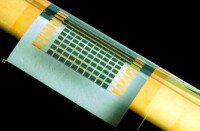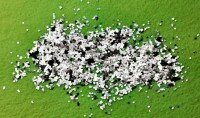University of Illinois Scientists demonstrate ways to create more effective PV panels
Posted in Technology on 06/07/2010 08:56 am by Even if silicon is actually the industry common semiconductor in most electrical units, which includes the cells that photo voltaic (PV) panels utilise to convert sunshine into energy, it is hardly the most cost-efficient product on the market. Nor, for example, is the semiconductor, gallium arsenide and connected substance semiconductors, which give practically twice the efficiency as silicon in solar units, but are rarely used in utility-scale applications mainly because of their excessive manufacturing price.
Even if silicon is actually the industry common semiconductor in most electrical units, which includes the cells that photo voltaic (PV) panels utilise to convert sunshine into energy, it is hardly the most cost-efficient product on the market. Nor, for example, is the semiconductor, gallium arsenide and connected substance semiconductors, which give practically twice the efficiency as silicon in solar units, but are rarely used in utility-scale applications mainly because of their excessive manufacturing price.
However, University of Illinois professors, J Rogers and X Li, have investigated lower-cost ways of producing thin films of gallium arsenide, which also create flexibility in the sorts of units they might be integrated into.
If you can minimise considerably the cost of gallium arsenide and some other compound semiconductors, then you might expand their own range of applications. Usually, gallium arsenide is placed in a single, thin layer on a small wafer. Either the desired unit is actually created on the wafer or the semiconductor-coated wafer is broken up into chips of the ideal size. The Illinois group chose to put in numerous layers of the material on a simple wafer, creating a layered, ‘pancake’ stack of gallium arsenide thin films.
If you grow ten layers in one growth, you only have to load the wafer once. Taking into account what is needed for each growth – the machine, the planning, the period and the workers – the overhead saving this represents is a significant expense reduction.
After that, the scientists independently peel off the layers and shift them. To achieve this, the stacks alternate levels of aluminium arsenide with the gallium arsenide. Bathing the stacks in a formula of acid and an oxidising agent dissolves the aluminium arsenide, freeing the single thin sheets of gallium arsenide. A soft, stamp-like system selects the levels, just one at a time from the top down, for exchange to one more substrate – glass, plastic or silicon depending on the application. The wafer can then be used again for one more growth.
By doing this, it’s possible to generate much more material a lot more rapidly and much more price effectively. This process could create mass amounts of material, as opposed to the thin, single-layer way in which it is typically grown.
Freeing the material from the wafer additionally opens the possibility of flexible, thin-film electronics produced with gallium arsenide or some other high-speed semiconductors. Making devices that can conform, but still keep higher performance, would be a considerable achievement.
In a document published online 20 May 2010 in the magazine, Nature, the group describes its methods and shows three kinds of units utilising gallium arsenide chips manufactured in multilayer stacks:
- Light products.
- High-speed transistors.
- Photo voltaic cells.
The authors additionally offer a detailed price evaluation.
An additional advantage associated with the multilayer technique is the release from area constraints, specifically crucial for solar cells. As the levels are eliminated from the stack, they could be laid out side-by-side on another substrate to produce a significantly bigger surface area, whereas the typical single-layer method limits area to the size of the wafer. For photovoltaics, you need large area coverage to catch as much sunlight as possible. In an extreme situation we may grow enough layers to have ten times the area of a conventional unit.
In the future, the team intends to investigate more possible device applications and additional semiconductor resources, which could adapt to multilayer growth.
 Shannon Combs contributes articles for the Residential Solar Power, her personal website, to assist home owners to conserve energy using solar power.
Shannon Combs contributes articles for the Residential Solar Power, her personal website, to assist home owners to conserve energy using solar power.

